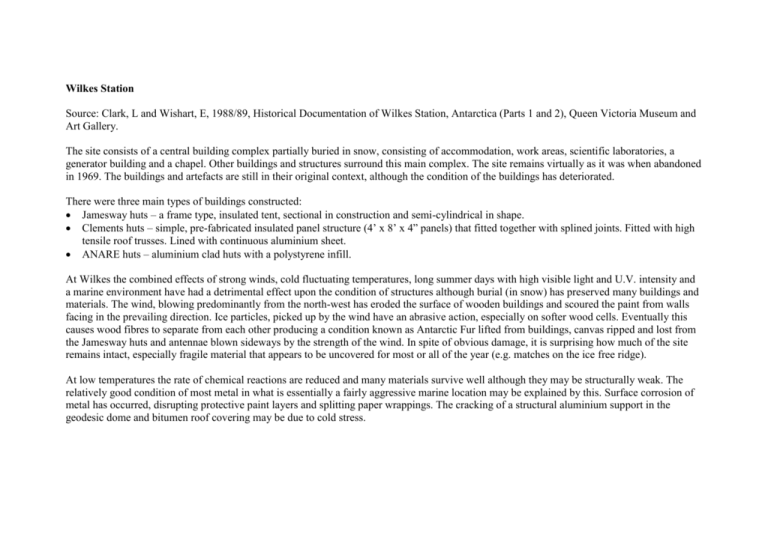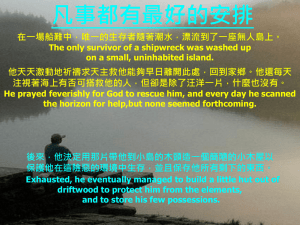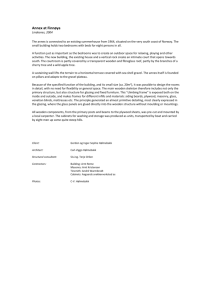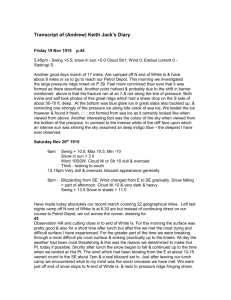Wilkes Station (Word
advertisement

Wilkes Station Source: Clark, L and Wishart, E, 1988/89, Historical Documentation of Wilkes Station, Antarctica (Parts 1 and 2), Queen Victoria Museum and Art Gallery. The site consists of a central building complex partially buried in snow, consisting of accommodation, work areas, scientific laboratories, a generator building and a chapel. Other buildings and structures surround this main complex. The site remains virtually as it was when abandoned in 1969. The buildings and artefacts are still in their original context, although the condition of the buildings has deteriorated. There were three main types of buildings constructed: Jamesway huts – a frame type, insulated tent, sectional in construction and semi-cylindrical in shape. Clements huts – simple, pre-fabricated insulated panel structure (4’ x 8’ x 4” panels) that fitted together with splined joints. Fitted with high tensile roof trusses. Lined with continuous aluminium sheet. ANARE huts – aluminium clad huts with a polystyrene infill. At Wilkes the combined effects of strong winds, cold fluctuating temperatures, long summer days with high visible light and U.V. intensity and a marine environment have had a detrimental effect upon the condition of structures although burial (in snow) has preserved many buildings and materials. The wind, blowing predominantly from the north-west has eroded the surface of wooden buildings and scoured the paint from walls facing in the prevailing direction. Ice particles, picked up by the wind have an abrasive action, especially on softer wood cells. Eventually this causes wood fibres to separate from each other producing a condition known as Antarctic Fur lifted from buildings, canvas ripped and lost from the Jamesway huts and antennae blown sideways by the strength of the wind. In spite of obvious damage, it is surprising how much of the site remains intact, especially fragile material that appears to be uncovered for most or all of the year (e.g. matches on the ice free ridge). At low temperatures the rate of chemical reactions are reduced and many materials survive well although they may be structurally weak. The relatively good condition of most metal in what is essentially a fairly aggressive marine location may be explained by this. Surface corrosion of metal has occurred, disrupting protective paint layers and splitting paper wrappings. The cracking of a structural aluminium support in the geodesic dome and bitumen roof covering may be due to cold stress. The summer thaw is potentially one of the most damaging agents of deterioration. Cracks in wood, running parallel to and against the grain are possibly explained by expansion of water as it freezes during the summer ‘night’. Where drainage is poor, melt water collects into ponds around the base of buildings spreading dampness through the walls and staining the wood. Plywood roofs sag under the weight of melted snow. The melts cause damage to some buildings by undermining their foundations. Pressure exerted by interior snow has forced the walls of some buildings outwards. Melting snow inside buildings leads to an increase in the interior humidity in summer giving rise to potentially increased metal corrosion and mould growth. The high and extended levels of radiation, especially U.V. radiation, during the long summer nights have contributed to the bleaching and weakening of organic materials. Summer visitors to Wilkes, trampling over buildings, tearing canvas to see what lies below, breaking skylights to gain access have caused considerable, probably mostly unintentional damage. The existence of the station in its present form itself poses an environmental threat. Chemicals, asphalt, acetylene and fuel are leaching out of rusting and perforated containers onto the surrounding snow and pose an enormous danger to wildlife. No. 1 Title Water tanks 2 Pump house 3 Reefers 4 Stores hut Description Wooden construction covered with canvas. Includes air vents, pipes and a trapdoor. Jamesway type building. Connecting canvas covered passage way to the reefers (see item 3). Evidence of pipes and rubber hoses. Large metal cylinder. Three walk-in type refrigerator units of metal construction linked by connecting corridors. One used for cold storage, the second changed to function as a heated store room and the third used as a clothing and amenities store. A Jamesway type building with boarded end with reinforced planking overlaid. Contains opened Condition/structural changes Canvas missing on roof although some remaining under battens. A number of canvas repairs and traces of a bituminous substance appears to have been added to the exterior surface in one section. Canvas patched with plywood. Canvas linings and patches. No. Title Description food crates containing tinned food. Not given. Clements hut, containing galley, mess and office. 5 6 Geomagnetic hut Galley and mess 7 Toilets and photo lab 8 Stores hut 9 Seismic building 10 Living quarters, skid row 11 Liquor store 12 Living quarters, Latin quarter 13 14 15 Medical lockers Electric shop Generator building 16 Plumbing and carpenters shop 17 Radio and meteorology building 18 19 Electronics building Stores hut Not located Jamesway hut only with roof visible. 20 Chapel Clements hut. Plywood reinforced with canvas and tar. Clements hut. Walls and roof were covered with asphalt of which remnants remain. Majority of building is under snow, only the roof is visible. Clements hut. Painted plywood panels on roof and walls with remnants of asphalt. Clements hut. Plywood panels coated with asphalt. Remnants of canvas strip around roof. Clements hut. Plywood with canvas covering and asphalt, reinforced by wooden planks. Clements hut. Roof is of plywood panels with canvas and asphalt. Not located Not located Clements hut. Building partially covered by snow. Plywood walls over-coated with asphalt. Clements building. Plywood panel roof and walls with asphalt covering. Building partially covered in snow. Clements hut. Includes three antennae and guy wires. Wooden roof covered with tar paper, hessian and canvas. Condition/structural changes Seriously damaged by wind in 1958. Loss of paint by wind abrasion. Roof skylights broken. Includes shelving inside with contents (food) in situ. Ice fills ¾ of building. Some ‘plumbing’ type modifications made. Not given Building was replaced by a new seismic hut erected during 1963-64. Not given Not given Skylights broken. One patch is evident on the roof. Traces of canvas at wester end. Plywood walls partially intact with some abrasion. Some modifications including footings and reinforcement. Roof trusses added to original flat roof. Remains of canvas on roof. Broken skylights. Some patching mainly in plywood and chipboard. Some abrasion of paint work. Theodolite stand mounted on roof shows signs of weathering. Broken skylights. Contains some equipment. Additions to building in 1959 to accommodate more equipment. Condition not given but corridor linking it to the science block (item 21) was constructed in 1961. Broken skylights. Some patching of plywood. Pews and altar still remain with bibles laid out on pews. Stained ‘glass’ perspex window removed and not held in Australian Antarctic Division No. Title Description 21 Science block Clements building. Plywood panels covered with asphalt. 22 Auroral tower 23 Welding shop 24 Garage Thirty to forty foot aluminium tower. Aurora building on top with access by a ladder. Only the roof is visible above the snow. Constructed from canvas covered wooden planks and bitumen. Clements hut from plywood. 25 Spare parts room 26 Recreation hall Clements hut from plywood with canvas over asphalt. Clements hut from plywood. 27 28 Field store Emergency radio building Not located. Not given 29 Balloon release building 30 Heater building 31 Radiosonde building 32 Store 33 New food store 34 Fire station 35 Jamesway huts Plywood construction mounted on a steel scaffold foundation. Masonite construction mounted on a wooden platform. Fibreglass dome bolted to a wooden platform guyed to a rock. Comprises eight panels and four windows. Wooden door. Lean to against the garage (item 24). Plywood and wooden plank construction with asphalt over the roof. ANARE hut – aluminium clad with polystyrene infill. ANARE hut - aluminium building insulated with polystyrene. Built 1961. Four Jamesway huts. Condition/structural changes in Hobart. Collapsed hatch on roof. Broken skylights. Some patching to plywood. Corridor linking it to the stored hut (item 19) was constructed in 1961. Tower collapsed circa 1969 Not given Traces of canvas remain. Some modifications and reinforcement work undertaken. Plywood patched in places. Majority of roof remains covered with asphalt and canvas. Remains of a chimney. Only remaining evidence is a concrete base with some reinforcement showing through. Not given Holes in masonite. Not given but appears fairly intact from the photo. Not given. Partially covered and filled with snow. Some panels missing. Part of the foundation platform has collapsed. Partially covered and filled with snow. Two exterior panels and two windows missing. Partially covered with snow. All full of snow. One hut virtually collapsed. Canvas seams split where stitching has deteriorated and a number of patches are in No. Title Description 36 Fuller geodesic dome 37 Transmitter hut 38 Sferics hut 39 HFDF building Aluminium dome with plastic fabric covering. Was later adapted for use as a penguin coop by covering the metal framework with chicken wire. ANARE building – aluminium clad with polystyrene infill. Built in 1960. Prefabricated building 10’ x 6’. Rests on a solid timber platform secured to ground by cables. Clements type hut. 40 Hydroneal building Only the wooden platform remains. 41 Dog lines 42 Crosses 43 Fuel platforms 44 Rubbish tip 45 Riometer aerial Remains of the dog lines include a number of wooden posts (to which chains were linked) and several metal dog plates on which the dog’s names were painted. Two graves marked by two painted wooden crosses. Crosses lie at the heads of two plywood coffins covered by a mound of stones. Two wooden stepped platforms mounted on scaffold bases that held large rubber bladders containing fuel. Was guyed to rock. Constructed during Australian occupation. Contains domestic and mechanical items from the ten years of occupation. Also included hazardous waste. Steel scaffold platform. Condition/structural changes place. In other places the canvas covering is missing. Framework is remaining consisting of aluminium bars and connecting plates. Collapsed entrance and mostly covered with snow. After abandonment of the station the hut was adapted and set up with bunks, shelving and a wood stove. Snow free and intact. Door is missing. Full of snow but hut still appears to contain most of its equipment. Building and equipment were removed to Casey where it was still in operation in 1988. Chains no longer in existence. Some weathering. Appear mostly intact from the photos. Not relevant. Not given.








